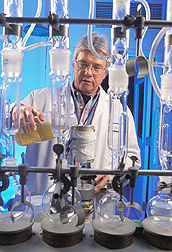This page has been archived and is being provided for reference purposes only. The page is no longer being updated, and therefore, links on the page may be invalid.
|
Read the magazine story to find out more. |
Boards and Resin From Guayule?By Marcia WoodApril 17, 2002 Plywoodlike boards made from a desert shrub called guayule might shrug off attack by voracious termites and wood-rot microbes. Preliminary results from Agricultural Research Service scientists and their colleagues show that guayule leftovers can be formed into durable, versatile substitutes for today's conventional plywood and particle board. Research chemist Francis S. Nakayama, with ARS' U.S. Water Conservation Laboratory in Phoenix, Ariz., leads these experiments. With its silvery, grayish-green leaves and yellow flowers, guayule--pronounced why-YOU-lee--somewhat resembles sagebrush. Hardy and drought resistant, guayule is native to the Chihuahuan Desert of the southwestern United States and northern Mexico. In tests, the scientists combined components of guayule plants with the whitish, translucent plastic of recycled milk or water containers. This yielded a composite material that resists costly insect and microbial damage, according to Nakayama. Guayule composite board might replace many kinds of wood that today are used in floor, wall and roof construction in homes and offices. Nakayama's colleagues made guayule components into prototype composite boards at the U.S. Forest Products Laboratory at Madison, Wis., for testing there and at the University of Illinois, Urbana. Their examinations showed that guayule boards made with high-density polyethylene from melted-down milk containers best withstood attacks by common termites and wood-rot microorganisms. In addition, guayule leftovers can be processed into resin for protecting wooden buildings, boats, decks and outdoor furniture. Nakayama and colleagues found that pine blocks impregnated with guayule resin resisted termite and wood-rot damage. Earlier, U.S. Navy investigations of candidate preservatives for wooden piers indicated that guayule resin thwarted several types of termites and marine borers. The guayule composite board and resin studies focus on using the brownish-white slurry that remains after guayule stems and leaves are ground up to remove their latex. Work by plant physiologist Katrina Cornish at ARS' Western Regional Research Center in Albany, Calif., has shown that guayule latex is hypoallergenic, and thus ideal for making medical and personal products such as surgical gloves, catheters and condoms. Details are in the April 2002 issue of the agency's Agricultural Research magazine. ARS is the U.S. Department of Agriculture's chief scientific research agency. |

